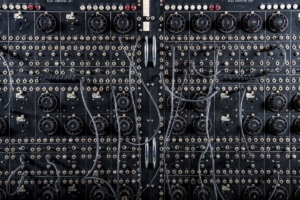Analog Computers and Modular Synthesizers
by Chris Meyer of LearningModular.com
Many fans of modular synthesizers look at the pre-digital analog computers of the 1950s and 60s, and assume they must have been inspiration for the first analog modular synthesizers created by Bob Moog and Don Buchla. But that’s not entirely true.
For those unfamiliar with them, analog computers solve problems in real time by simulating physical objects with electronic modules. These general-purpose modules are patched together and tweaked to get an idea of how a physical system would respond. Many of their components – such as attenuators, oscillators, amplifiers, integrators (filters), adders (mixers), and the such – have analogies in the modular synthesizer world.
Take the problem of simulating an automobile suspension with an analog computer: The weight of the car is set using a bias or offset voltage. A bump that it hits in the road can be simulated by a transient or envelope generator. The bounce and rebound of springs are similar to a resonant filter (hopefully not too resonant!); the damping of a viscous shock absorber is similar to a slew limiter. It is easy to test variations on a suspension’s design by tweaking the parameters of these electronic circuits.
However, neither Bob Moog nor Don Buchla are known to cite analog computers as an inspiration for their work. Herb Deutsch has mentioned in interviews that Moog was inspired by an automated automobile assembly plant nearby, which used voltages to control the movement of hoists and the such. And when asked how he arrived at the voltage control approach, Buchla – who had backgrounds in music, engineering, and physics – replied “I don’t know. I just did it.”
Instead, it was Alan R. Pearlman who had a very direct connection with the analog computing world. A co-founder of Nexus Research Laboratory in Canton, Massachusetts, he designed multipliers and amplifiers for military- and space-grade analog computers. Pearlman applied this technology to create the more stable circuits that ARP modular synthesizers were known for, especially when compared to the early Moog and Buchla models. In a nod to his days at Nexus, exponential converter circuit components were even listed as items for sale in the early ARP 2500 catalogs.
Another example of the connection to analog computers can be found in the Audio Engineering Society paper engineer Dennis Colin wrote on the 1047 Multimode Filter Resonator. In it, he wrote that “the filter is basically an analog computing circuit consisting of summers and integrators, set up to solve a second-order differential equation. The circuit is well known and documented in analog computer and servomechanism fields.” An example includes the EG&G Parc Model 189 Selective Amplifiers shown below. The difference was that Colin added voltage control to several parameters, making the design more usable in a music creation context.
Today, some electronic musicians are going back to the early days of electronic music, integrating electronic test equipment and – yes – analog computers into their music-making process. But it was Alan R. Pearlman who most directly bridged the gap from analog computers to modular synthesizers.





